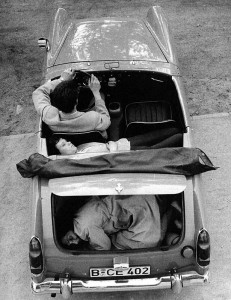COLD WAR CHILLS
The Wall came down in 1989. Over 20 years ago. It’s easy to forget what it was like for the people living on both sides of it at the time.
NATO had a very important role during the time of The Wall, and Germany and America were especially close partners. Did you know that Germany had Air Force facilities in the U.S. (and still does)? During the later part of the Cold War, I had business with the German Air Force, and flew out of a tightly guarded German facility at Dulles Int’l. Airport. High cyclone fences topped by razor wire, lots of uniformed guys with submachine guns and German Shepherds. A little foreshadowing …
We crossed the Atlantic in an immaculately preserved old Boeing 707. It was a pleasant enough flight, but it felt a bit strange to look out my window and see the German Iron Cross insignia painted on the wing – the insignia of the enemy in all those war movies. We’re talking Luftwaffe, here, not Lufthansa.
The German pilot brought us into the Cologne airport with a flawless landing. As we were taxiing along a main runway, he suddenly turned the plane down a narrow concrete strip and we disappeared into the forest. More guys with submachine guns and German Shepherds flanking the strip. We came to a stop at a hidden WWII-vintage aerodrome and debarked through a really rigorous security process.
The significance of what seemed like over-the-top German security (even before we left the U.S.) began to sink in and I started to get a sense for the real threat they were responding to. The guys on the West side knew what it was like for their counterparts on the other side of The Wall, and were not about to allow that for themselves. The guys on the East side knew what life was like for their counterparts on the West side of The Wall and many would risk death to have the same kind of life instead of what they had at the time.
The great difficulty of getting past that wall was itself a sort of gauge of how bad it was on the East side. The more people tried to escape, the more the E. German government added barriers; the more barriers, the more the people were convinced they needed to escape such a place. And of course more barriers – and more sophisticated ones – meant getting out was a more complex problem, requiring complex strategies. What better example for us to use for devising a complex strategy? But first, a little diversion into what complex strategies really are.
What a complex strategy is
It’s just like a simple strategy, made of the same 6 elements, but it has more than more than one objective and/or more than one barrier and/or more than one kind of vulnerability, etc. But complexity like this is normal for us all.
Since we can have multiples of elements, the connections between elements become important. For instance, maybe one of our objectives has two barriers and another objective has a different barrier from the other two. In the diagrams we use in the companion post to this one, the connections are shown as lines.
The elements and their relationships (connections) together completely define a given strategy. Any and all strategies can be defined in this way. This concept of a strategy is called the General Strategy Model (GSM).
Dealing with complexity
All complex strategies can be seen to consist of substrategies. That’s good news. Every substrategy is itself a strategy, so it can simply be devised in the way we talked about in the post How to Devise a Strategy.
Nature is full of complex strategies at work. Generally, they’re based on very simple substrategies. The beautiful orb spider web seen in gardens was constructed by the spider by repetitively using a few remarkably simple substrategies.
There are different types of complexity. One common type is Prerequisite Complexity. You can’t reach Objective A until you first reach Objective B, and you can’t reach Objective B until you’ve first reached Objective C, etc. Here’s Betty the Crow devising a complex prerequisite strategy to get at some food: www.wimp.com/threetools/ She’s broken her strategy down into 3 substrategies. Check it out.
The long, and even the medium tool, were too far for Betty to reach. So her first substrategy was to get the short tool and use it to reach the medium one, the 2nd substrategy was to use the medium one to reach the long one, and the final substrategy was to use the long one to reach the food. Each of the substrategies was made up of the usual 6 strategy elements. The high level strategy consisted of a string of substrategies. When the final substrategy objective was accomplished (and not until), so was the objective of her high level strategy.
Pretty smart – she didn’t even need to jot anything down on paper.
Representing Strategies
But as the complexity of situations increase, strategies for dealing with them quickly become too difficult to keep in one’s head. Even a crow’s head. So we need a way to represent them visually. The best way I’ve found to do this is to draw a couple of simple diagrams.
This allows breaking out substrategies into manageable units that we can keep in our heads and go after like we did in How to Devise a Strategy. Also, in the case of big, complex strategies being developed by a group of people, breaking out the substrategies allows their allocation to different members. E.g. the offensive coordinator and defensive coordinator of a football team may be responsible for developing their respective game substrategies.
Let’s get back to our E. Berlin escape …
Berlin Wall: Strategies for Getting to the Other Side
The Wall was begun in 1961. At first it was limited in size and sophistication, and escapes were relatively common. So the E. German government poured huge resources into reducing vulnerabilities in the barrier they had constructed.
Eventually the wall between E. Germany and W. Berlin was 69 mi. long. It was backed up by a wide swath of ancillary barriers that included, among other impediments, anti-vehicle trenches, electric fencing, contact-wire alarms, trip-wire-activated flares, flood lights, 302 watchtowers, and 20 bunkers. And, yes, a whole lot of guys with submachine guns and German Shepherds.
This stimulated a brisk business in tunnel building and paid-for escapes from the basements of nearby E. German homes – which eventually were all torn down. With climbing the wall impossible, creativity came to the fore in the form of home-made airplanes, hot-air balloons, water floatation devices, etc. In one instance, a guy arranged to quickly get a cable strung between high buildings on either side of the wall, and rode across to freedom using a pulley wheel device he’d constructed for the purpose.
One very attractive vulnerability in the wall, from early on, was the gates into W. Berlin (Checkpoint Charlie, etc.). Not lost on the E. German authorities, they had constructed many barriers in the checkpoints on their side, to control the flow of people and goods moving from E. to W. People hid in packing boxes, and even suitcases, to be smuggled through. But the most creative and successful strategies for escaping through the checkpoints were based on modifying vehicles.
At least 3 approaches were used: modifying a very small car that guards wouldn’t imagine could possibly hide a passenger (e.g. Car A ), modifying a car to fit through the checkpoint barriers (e.g. Car B), and modifying a car so that it could withstand the guards’ machine gun fire.
Notice the missing windshield on car B, which together with letting air out of the tires, made the car just low enough to precisely scrape under the bottom of a checkpoint’s lowered guard pole – at speed, of course. They used a sheet of steel to protect the mother-in-law in the trunk.
In the example we’ll now use, Achim Weyer chose the 3rd approach for his attempt. He bought a heavy old 1930’s Opel (not shown) for the purpose and spent 3 months planning the escape and modifying the car.
The history of serious escape attempts shows that successful ones almost always entail a great deal of detailed planning/strategizing based on close observation, followed by totally committed execution of the plan. And this was how Weyer approached the problem.
He poured concrete into the inside of the doors, and added steel plates in critical places of the car body. He also put steel plating behind the windshield, and drilled holes in it for just enough visibility to get the job done. And he further added various other pieces of armor as needed.
In a big decision, he chose the Chausserstrasse checkpoint as where he’d do his deed. It was less busy than the others, so there was less chance of traffic backups and other unpredictable situations. Also, it had the shortest distance (~ 60m) from the last guard house to The Wall – the actual border – reducing the amount of time he’d be exposed to machine gun fire.
If in the first place he made it to the checkpoint in his weird, suspicious-looking car, his barriers would then be a slalom of obstacles that limited his speed, and machinegun-bearing guards stationed at the slalom curves.
After the car was ready, he chose a cold, rainy November night to make his run for it. He loaded in his fellow escapees – his wife, mother and a married pair of friends. They navigated in the darkness to a point about 150m from the entrance to the first guardhouse, and watched for an hour to observe the night’s pattern of traffic and guard activity, and further substantiate their plan.
The passengers got ready, lying down on their seats. Then he went for it. Weyer started to drive up to the first guard house. As he neared it, a guard stepped out to stop him. Weyer accelerated past the guard, who threw himself out of the way and blew his whistle.
Forewarned, a guard at the next curve showed up with a submachine gun. Weyer aimed straight for him, and he jumped aside, too.
By this time the guards at the next and final curve were waiting for him, machine guns loaded and aimed. They immediately opened up on the car, shooting out the tires, blasting the windows, and riddling the entire car body. The engine took some fire, too, and the car became hard to control.
Then all the noise stopped. The car wheezed another 150m, and came to rest. It sat there in silence for a half minute. Then Weyer could make out where they were: in front of a West Berlin clothing store!
People came running to see if anyone was alive and could be helped. The Polizei, running hot, arrived and pulled up to the car. Looking at the riddled hulk with its shredded tires, the policeman asked through a shattered side window how many were dead and injured.
Weyer was able to answer “none”.
In fact, only one bullet had penetrated, and it hadn’t caused injury. The strategy worked.
A brief look at the strategy
Are you getting sleepy? This piece is getting pretty long for a blog post. I’ll just summarize the process here, and provide more design detail and how-to information in a companion post, for those so inclined.
The process of devising a complex strategy is to sketch it out in the form of two kinds of diagram:
- Sketch an Objectives Diagram
- Showing the overall objective(s) and the sub-objectives that are prerequisites for accomplishing the overall one(s)
- This provides a picture of all that needs to be accomplished to meet the overall objective(s)
- Sketch a Strategy Diagram of the strategy for any sub-objective that needs to be detailed
- Usually some sub-strategies will require this, but most won’t – keep it simple
That’s all there is to it.
Both diagrams are shown and explained in the next post, Escaping E. Berlin; A Simple Way to Devise Complex Strategies (2)
__________________________________________________
Readers are encouraged to add comments to this post.
And if you’d like to share or recommend the post, click on your preferred way in the left margin sidebar.
If you’re not currently being automatically notified when new posts are published, then please Follow Real Strategy (top of right hand column on this page), and indicate how you’d prefer to be notified.
For other posts of interest, look in the Smart Menu.
Photo credit: Car A, anonymous photographer & author at travel site
Photo credit: Car B, from Rainer Hildebrandt, It Happened at the Wall, Verlag Haus
BYB6NREXZYJG









Betty’s family is pretty cool. Here is her cousin:
http://www.wimp.com/crowtubing/
[Translate]
Amusing Bill.
Best Carl
[Translate]
Bill, good story!
[Translate]
Bill, good story, could be a movie!
[Translate]
Thanks Robert. I haven’t settled on a Director yet. Maybe Spielberg. Wait – I’ve got it: Werner Herzog!
[Translate]